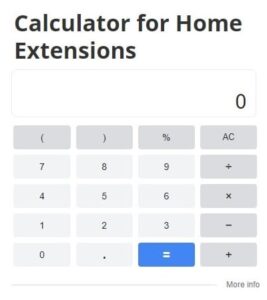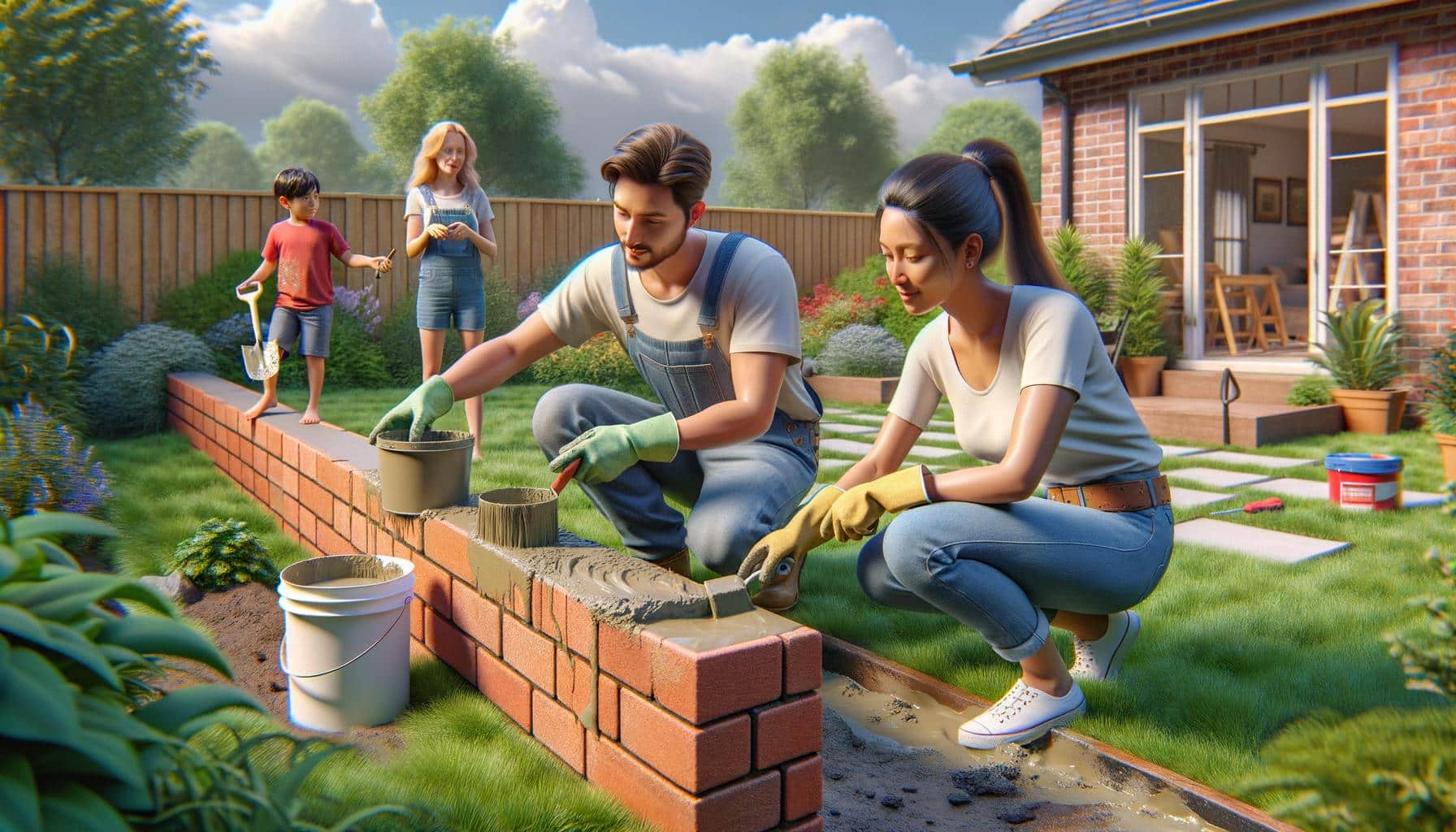
At Home Owners Association, we understand the critical role of retaining wall waterproofing in protecting your property.
A well-waterproofed retaining wall safeguards against soil erosion, structural damage, and costly repairs. This guide will walk you through effective methods to keep your retaining wall dry and durable for years to come.
Learn how to identify potential water issues and implement the right solutions for your specific wall type.
Why Waterproof Your Retaining Wall
The Hidden Dangers of Water Damage
Water poses the greatest threat to retaining walls. Moisture infiltration can trigger a cascade of problems, from minor cracks to complete structural failure.
Hydrostatic pressure ranks as one of the most prevalent issues we encounter. As water accumulates behind the wall, it exerts force that can result in bowing, cracking, or even collapse. This problem becomes particularly acute in areas with heavy rainfall or inadequate drainage.
Spotting Water-Related Issues
Early detection of water problems prevents major damage. Watch for these warning signs:
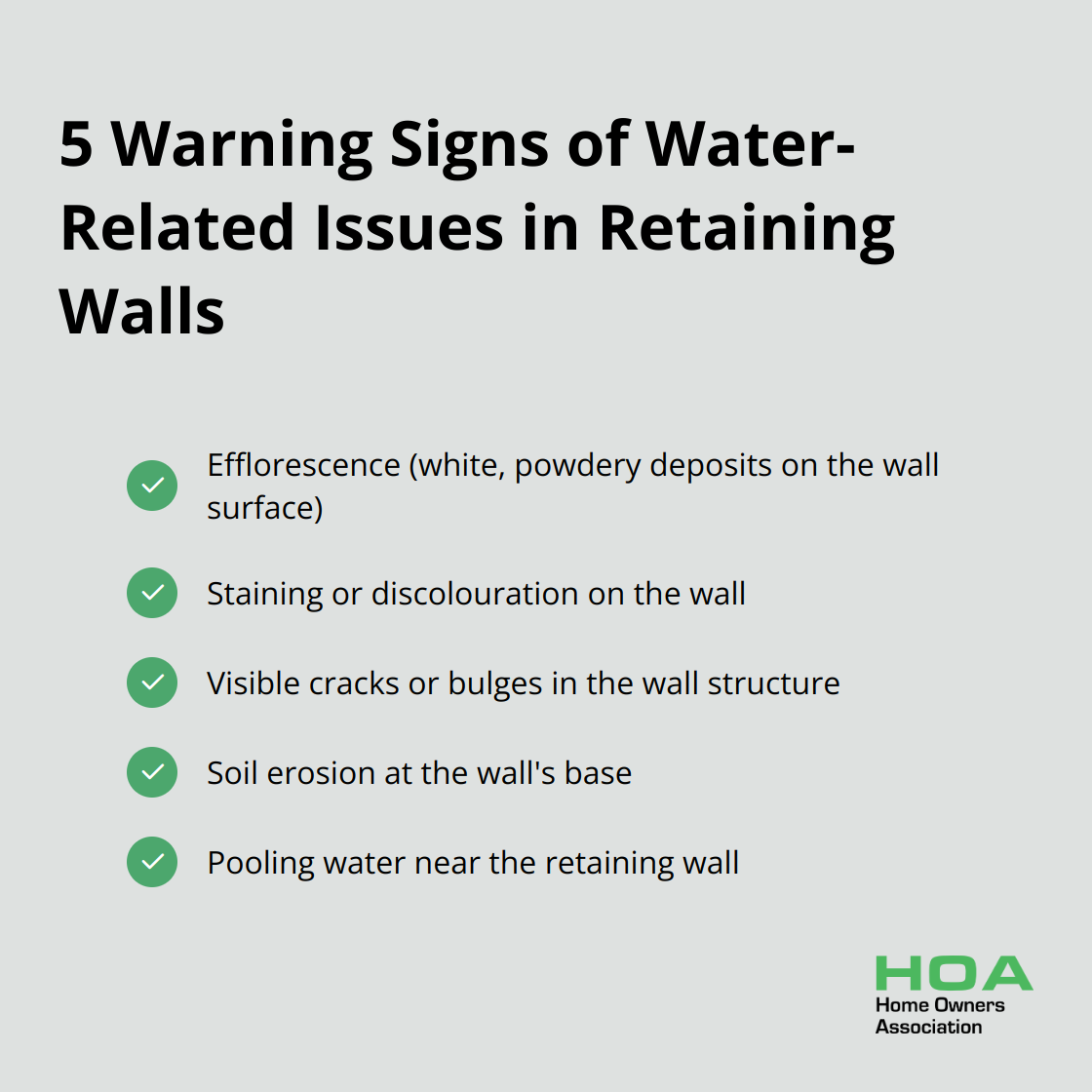
- Efflorescence (white, powdery deposits on the wall surface)
- Staining or discolouration
- Visible cracks or bulges
- Soil erosion at the wall’s base
- Pooling water near the wall
If you notice any of these issues, take immediate action. Procrastination will only lead to more extensive (and expensive) repairs in the future.
Customising Waterproofing for Your Wall Type
Different retaining walls require specific waterproofing strategies. For concrete walls, a penetrating sealer proves highly effective. These products create a water-resistant barrier within the material itself.
Masonry walls often benefit from a combination of surface sealants and proper drainage. We suggest using a high-quality masonry waterproofer, which forms a protective coating while allowing the wall to breathe.
Timber retaining walls present unique challenges. While water-repellent preservatives can help, it’s important to note that these walls have a shorter lifespan than concrete or masonry alternatives. Regular maintenance and inspection are essential for timber walls.
Regardless of wall type, proper drainage remains paramount. Installing an effective drainage system behind the wall can alleviate much of the hydrostatic pressure that leads to water damage.
The Role of Professional Assessment
While DIY solutions can address minor issues, complex waterproofing often requires professional expertise. Home Owners Association (established in 1980) offers members access to trade pricing and discounts on construction materials, potentially reducing the cost of professional waterproofing services.
Expert assessment can identify hidden vulnerabilities and recommend tailored solutions for your specific retaining wall. This proactive approach can save you significant time and money in the long run.
As we move forward, we’ll explore the most effective waterproofing methods for various situations, equipping you with the knowledge to protect your retaining wall and property from water damage.
Proven Waterproofing Techniques for Retaining Walls
Penetrating Sealers: Your First Defence
Penetrating sealers offer an excellent starting point for waterproofing concrete and masonry retaining walls. These products infiltrate the porous surface to create a hydrophobic barrier that repels water while allowing the wall to breathe. For best results, apply the sealer when the wall is completely dry and the temperature ranges between 10°C and 25°C.
The rate of water absorption in concrete can be significantly reduced by using high-quality penetrating sealers. This substantial decrease in moisture ingress can significantly extend your retaining wall’s lifespan.
Advanced Drainage Solutions
Proper drainage plays a vital role in retaining wall waterproofing. Installing a robust drainage system will alleviate hydrostatic pressure and prevent water buildup behind the wall.
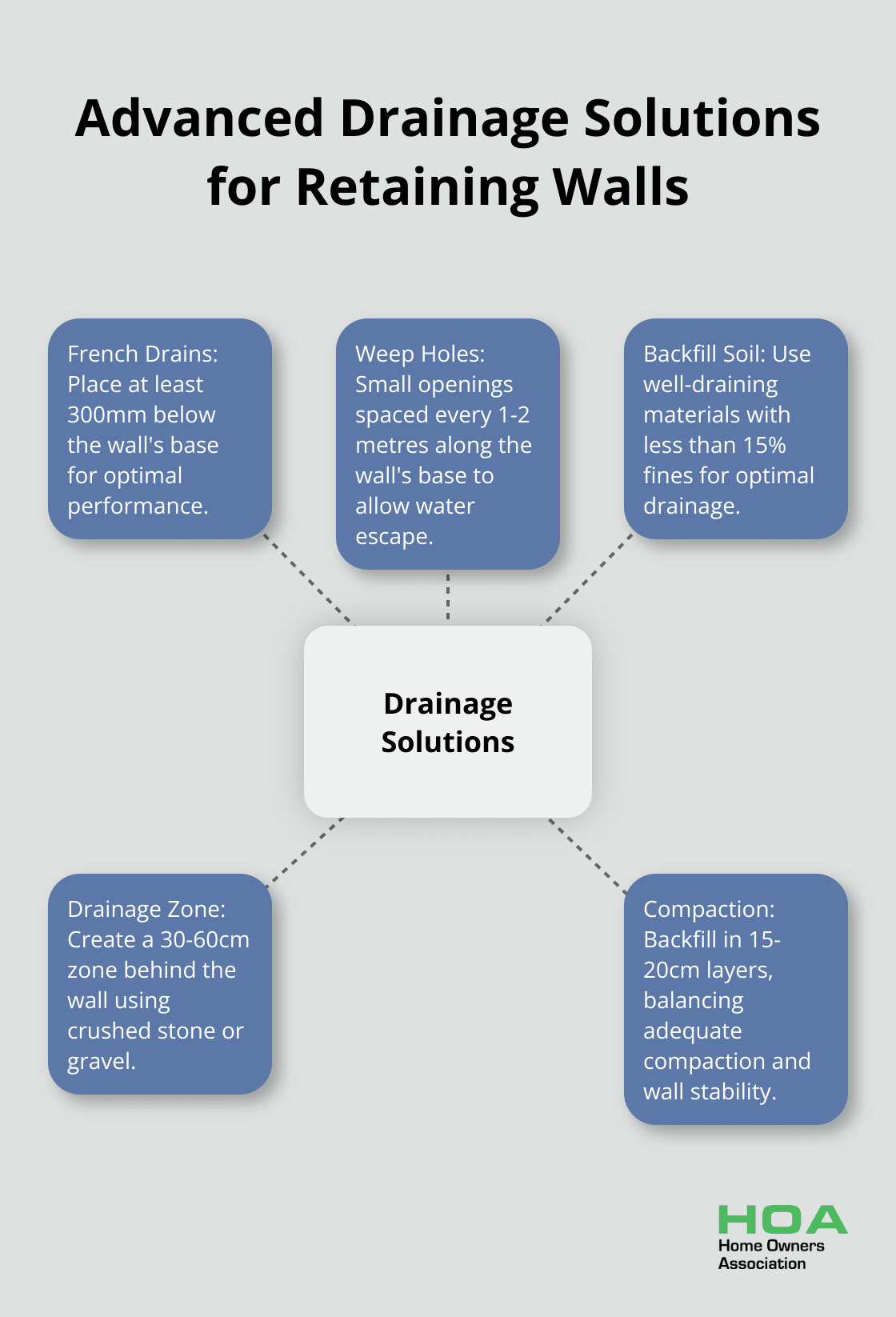
French drains provide an effective method. This involves creating a trench filled with gravel and a perforated pipe that channels water away from the wall’s foundation. The Australian Geomechanics Society advises placing the drain at least 300mm below the wall’s base for optimal performance.
Weep holes constitute another essential component of effective drainage. These small openings (typically spaced every 1-2 metres along the wall’s base) allow water to escape. Protect these holes with filter fabric to prevent soil erosion while maintaining water flow.
Waterproof Membranes: Maximum Protection
For areas with high water tables or severe moisture issues, waterproof membranes provide superior protection. These sheets or liquid-applied coatings establish an impermeable barrier between the soil and the wall.
When choosing a membrane, consider its elongation properties. AS 4654.1-2012 sets out the requirements for waterproofing membrane materials, ensuring they are fit for purpose, durable, and capable of withstanding structural movements.
Membrane application requires meticulous attention to detail. Ensure all seams overlap and seal properly. Pay special attention to corners and penetrations, as these often become weak points in waterproofing systems.
Backfilling: Completing the Waterproofing Puzzle
Proper backfilling often gets overlooked but remains essential for effective waterproofing. Use well-draining materials like crushed stone or gravel for the first 30-60cm behind the wall. This creates a drainage zone that allows water to move freely towards the drain system.
Avoid using clay-rich soils for backfill, as they retain water and increase hydrostatic pressure. The Geotechnical Society of Australia recommends using soils with less than 15% fines (particles passing through a 75-micron sieve) for optimal drainage.
Compact the backfill in layers (typically 15-20cm thick) to prevent settlement and ensure consistent drainage. Over-compaction near the wall can increase lateral pressure, so maintain a balance between adequate compaction and wall stability.
These proven waterproofing techniques will significantly enhance the durability and performance of your retaining wall. The cost of proper waterproofing represents a fraction of the potential repair costs associated with water damage. Quality materials and professional installation yield the best long-term results.
As we move forward, we’ll explore the pros and cons of DIY waterproofing versus professional services, helping you make an informed decision for your retaining wall project.
DIY or Professional Waterproofing for Your Retaining Wall
Assessing the DIY Approach
Waterproofing your retaining wall yourself can appear cost-effective, but it carries risks. Many homeowners underestimate the complexity of proper waterproofing techniques.
Common errors include:
- Inadequate surface preparation
- Incorrect product application
- Failure to address underlying drainage issues
These mistakes can result in water infiltration, structural damage, and expensive repairs in the future.
When to Hire a Professional
Professional waterproofing becomes necessary (and often required by local building codes) for retaining walls over 1.2 metres in height. Australian Standard AS:4678 outlines specific design and construction requirements for retaining walls, including proper waterproofing measures.
Expert intervention is also essential for:
- Complex soil conditions
- High water tables
- Walls supporting significant loads
Professionals have access to specialised equipment and high-grade materials that may not be available to the average homeowner.
Cost Considerations
While DIY waterproofing might reduce initial expenses, it can lead to higher costs long-term. Professional waterproofing for a standard retaining wall typically costs between $2,000 and $6,000 (depending on size and complexity). However, repairing a failed DIY job can easily exceed $10,000, not including potential damage to surrounding structures.
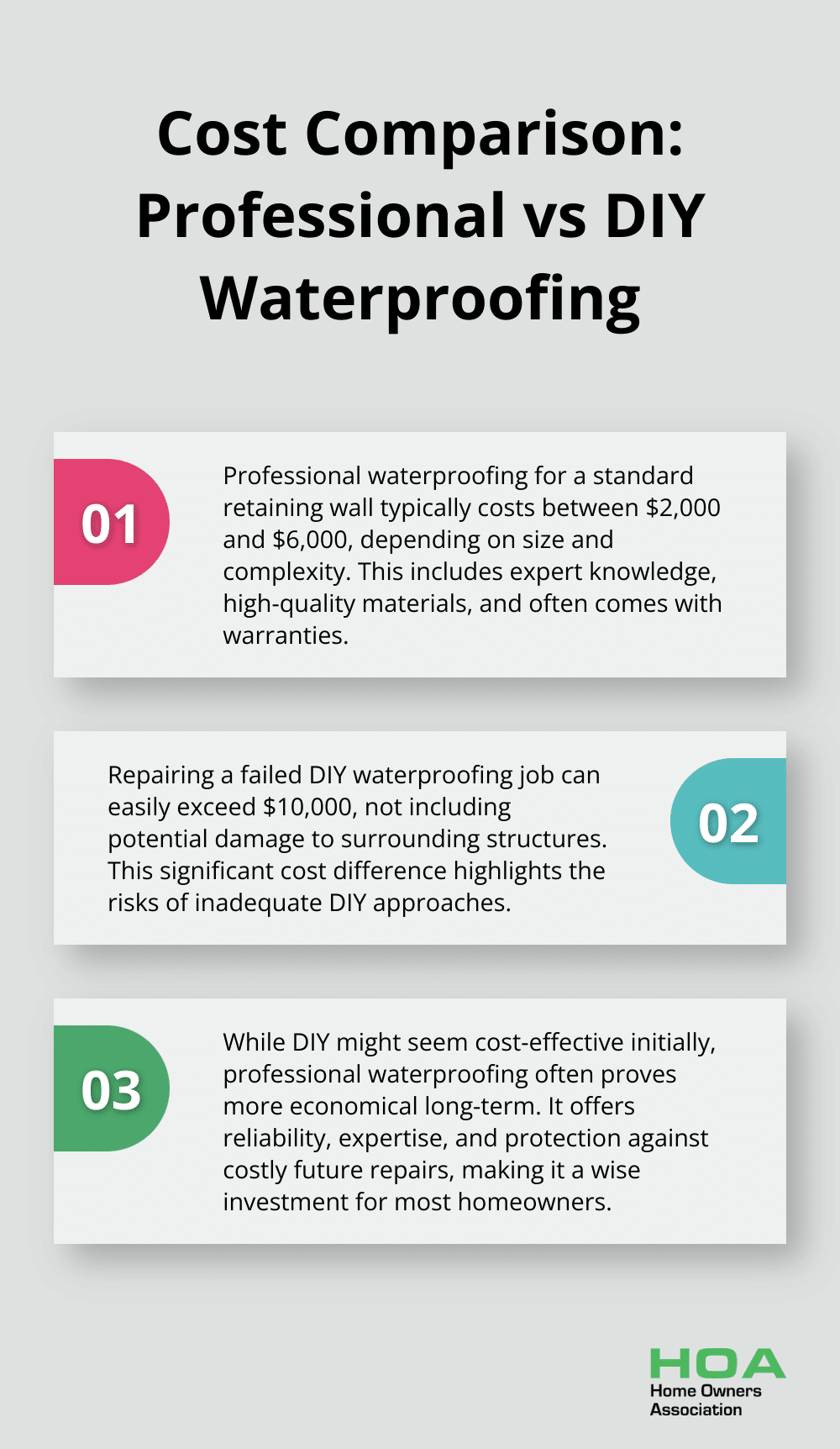
Expertise and Guarantees
Professional waterproofing services offer:
- Expert knowledge of local soil conditions
- Access to high-quality, commercial-grade materials
- Warranties on workmanship (often lasting several years)
These benefits provide peace of mind and can save money in the long run.
Making the Right Choice
The decision between DIY and professional waterproofing should stem from a careful assessment of your wall’s specific needs, your skill level, and the potential risks involved. For most homeowners, the expertise and guarantees offered by professional services outweigh the perceived savings of a DIY approach.
Final Thoughts
Retaining wall waterproofing protects your property from water damage and structural failure. Professional waterproofing offers reliability and long-term cost-effectiveness, especially for complex projects or walls over 1.2 metres high. Experts provide specialised knowledge, high-quality materials, and valuable warranties that safeguard your investment.
A well-waterproofed retaining wall resists erosion, prevents soil contamination, and maintains its structural integrity for decades. This results in fewer repairs, lower maintenance costs, and increased property value over time. Regular inspections and prompt addressing of minor issues will extend the life of your waterproofing measures and ensure continued protection for your property.
The Home Owners Association offers valuable resources and support for homeowners in Melbourne seeking expert guidance on retaining wall waterproofing. Members can access trade pricing, discounts on materials, and personalised advice to tackle their waterproofing projects with confidence. Professional expertise and quality materials will help ensure your retaining wall stands strong against water damage for years to come.





